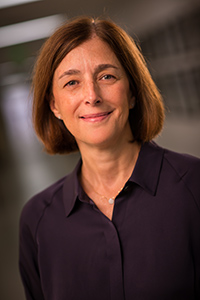The Promise of Precision Medicine: Searching for the Correct Needle among Many Haystacks

As a disease, cancer lends itself particularly well to precision medicine.
Cancer has a huge impact in the United States where the American Cancer Society estimates 1.7 million people will be newly-diagnosed with the disease in 2016. On top of that, there are an estimated 15.5 million cancer survivors today – a number expected to exceed 20 million by 2026.
To understand the incredible potential of applying precision medicine to cancer, consider the findings of the National Institutes of Health Human Genome Project. Every person has two pairs of 23 chromosomes. Each chromosome contains hundreds to thousands of genes, with an estimated 30,000 genes in the human genome. Approximately 1,000-2,000 of these genes are implicated in cancer. So how do we identify, target and treat the genes associated with a person’s cancer?
The current answer is, not easily. Kathleen Cooney, M.D., chair of internal medicine and investigator at Huntsman Cancer Institute at the University of Utah, describes the “holy grail” of precision oncology as follows: sequence a tumor, identify a gene mutation, match a patient to the drug which specifically targets the mutant gene, and get a dramatic response. But the practice rarely follows this pattern.
The results of a tumor sequencing test generate a huge amount of data, but most often many of the findings are not linked to known drugs. Further complicating the matter, the combination of genetic factors in each individual may play a major role in determining response to a treatment. Even if a drug exists, many patients go on to develop a resistance to that drug.
While progress has been made in the field of precision oncology, much needs to be done to apply findings to the general public. Take for example the findings of a study at Princess Margaret Cancer Centre. From 2012 to 2014, 1,893 advanced cancer patients were enrolled and 1,640 had their tumors sequenced. Of those patients tested, only 15 percent had findings that matched them to a clinical trial, and only 5 percent were matched to a clinical trial associated with their genotype. The 5 percent of patients who were matched on trials associated with their genotype had better outcomes than those who were referred to non-genotype trials.
Scott Tomlins, M.D., a molecular pathologist at the University of Michigan, says cancer centers face competition-driven market pressures to offer precision medicine sequencing. Tomlins asserts that cancer centers must avoid over-promising on the impact of precision medicine based on the knowledge we have today. Precision oncology has shown limitations in being generalizable and efficacy in patients with late-stage cancers. Tomlins says it isn’t enough to simply offer the sequencing. Sequencing must be coupled with clinical trials, and the findings of the study must prove the study can be cost effective if put into clinical practice. According to Tomlins, “All of the data says we are going make more impact in patients with early disease.”
With the selection of oncology drugs available today, approximately 5 to 10 percent of patients who have a tumor sequenced will be matched to a trial. The challenge is identifying who among those patients is a good candidate for a response. Tumors are very savvy, and once a patient is treated with a drug, the tumor starts to develop drug resistance. This requires researchers to understand how the tumor behaves over time. For example, what alterations are present at the beginning of treatment? What changes happen after treatment? While this knowledge may not change the treatment course, it can inform the design of clinical trials, helping match the right patient to the right trial at the right time.
The phenomenon of “exceptional responders” also presents unique challenges to scientists. “As scientists, we are fascinated by rare things, including exceptional responders,” Cooney says. “Further, I am fascinated by exceptional non-responders. These patients teach us a lot about the molecular biology of cancer.”
So how can we advance the promise of precision oncology, when we are searching for a needle hidden among many haystacks? Clinical trials with broad collaboration are key. Trials offered at a single institution aren’t likely to accrue enough patients to represent statistically significant clinical findings. In any given geographic area, only a handful of patients may share a common genetic alteration.
In 2016, Huntsman Cancer Institute joined the Oncology Research Information Exchange Network (ORIEN), linking with more than a dozen cancer centers across the country. This initiative offers patients access to a network of trials for targeted treatments.
